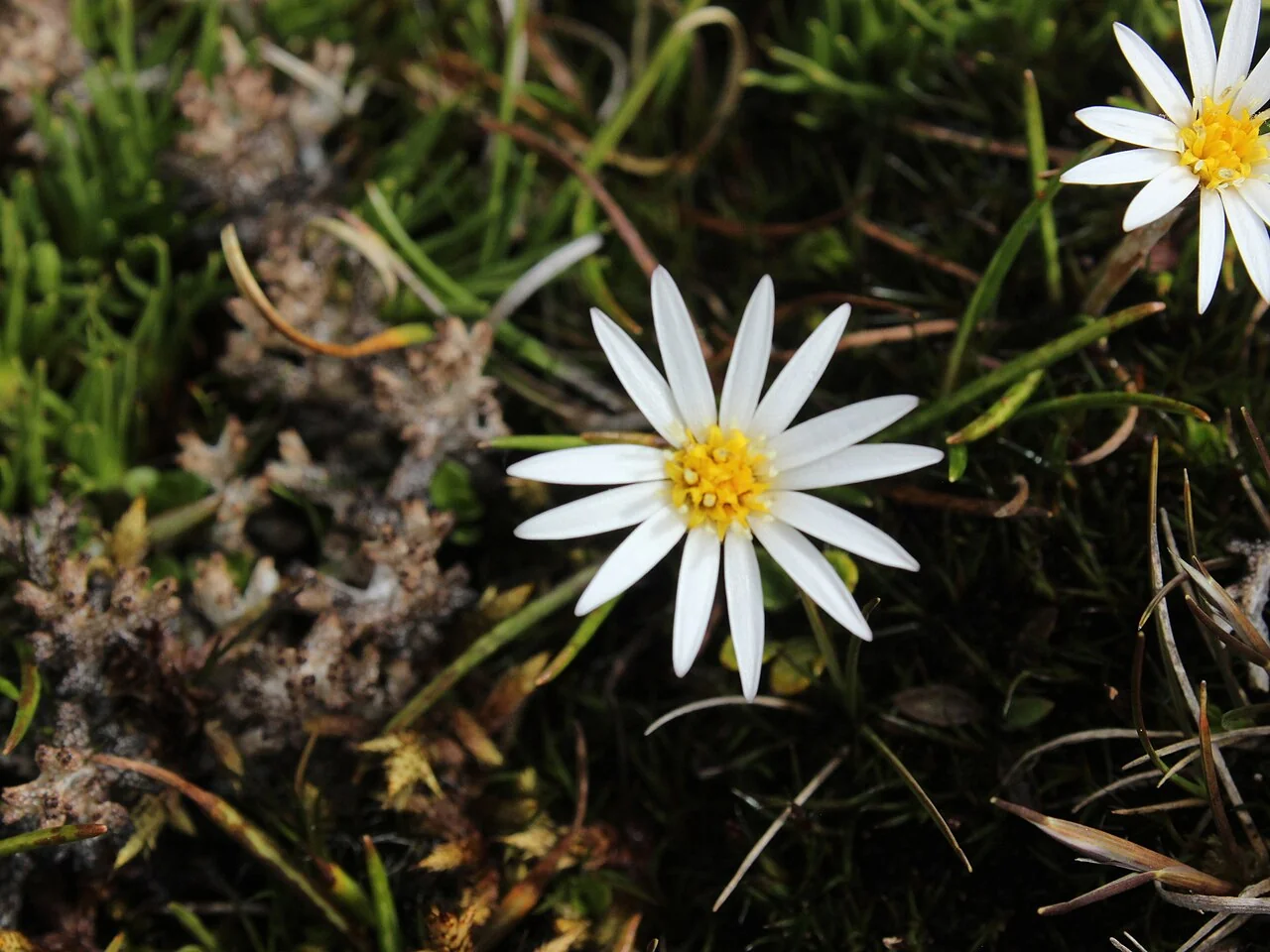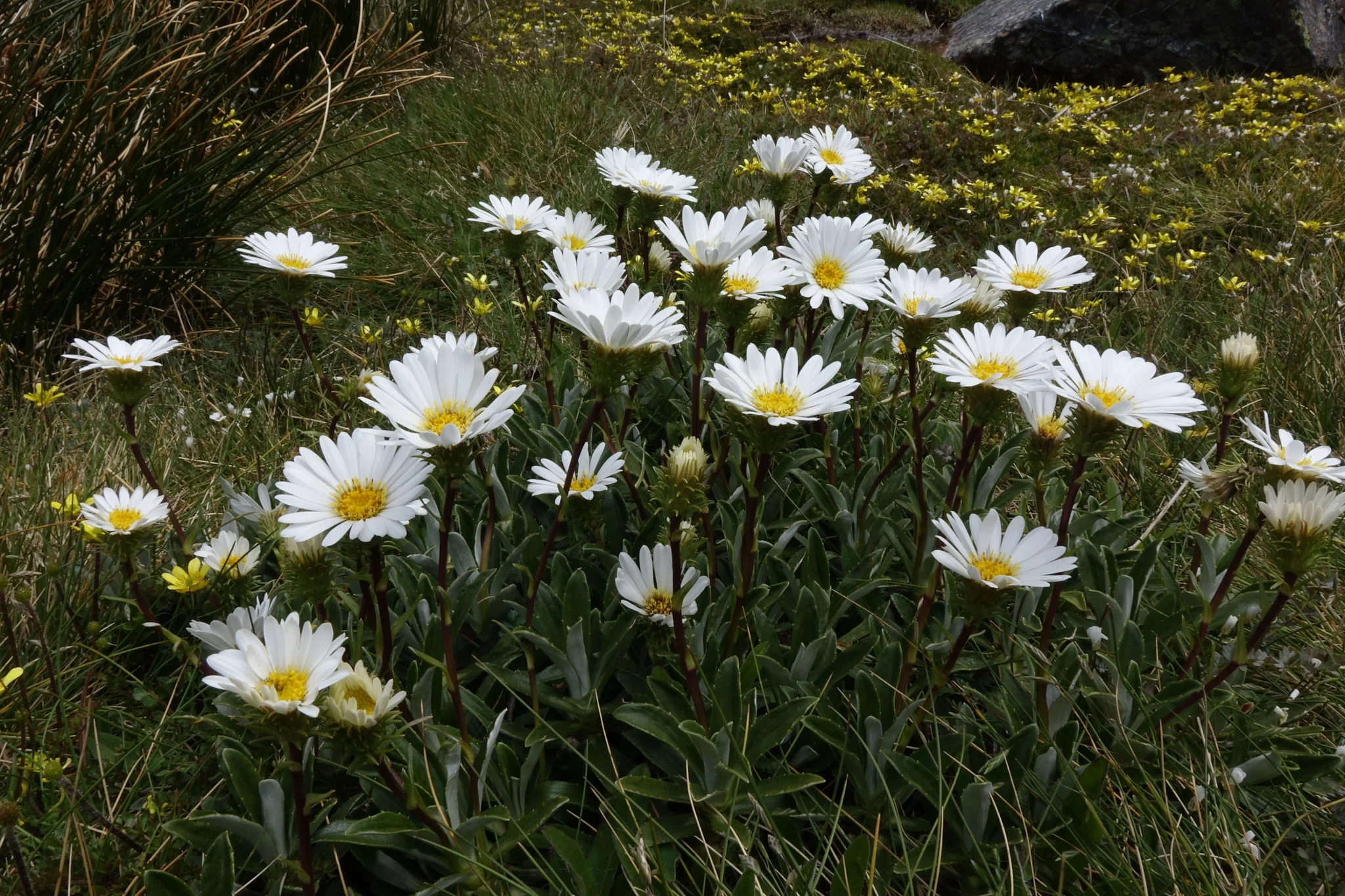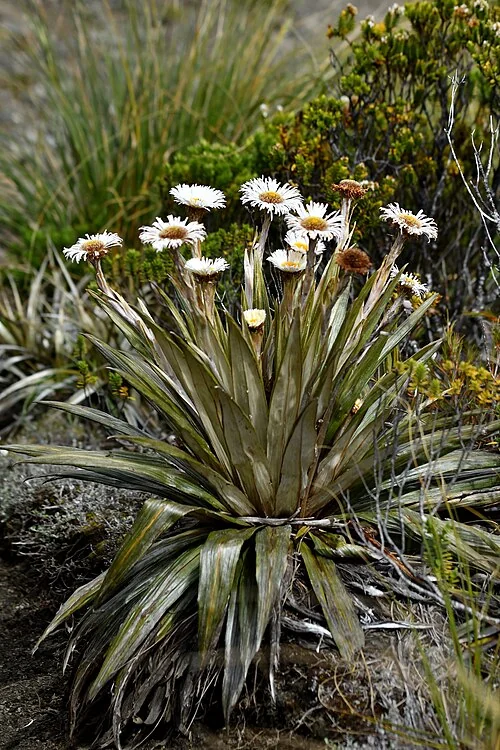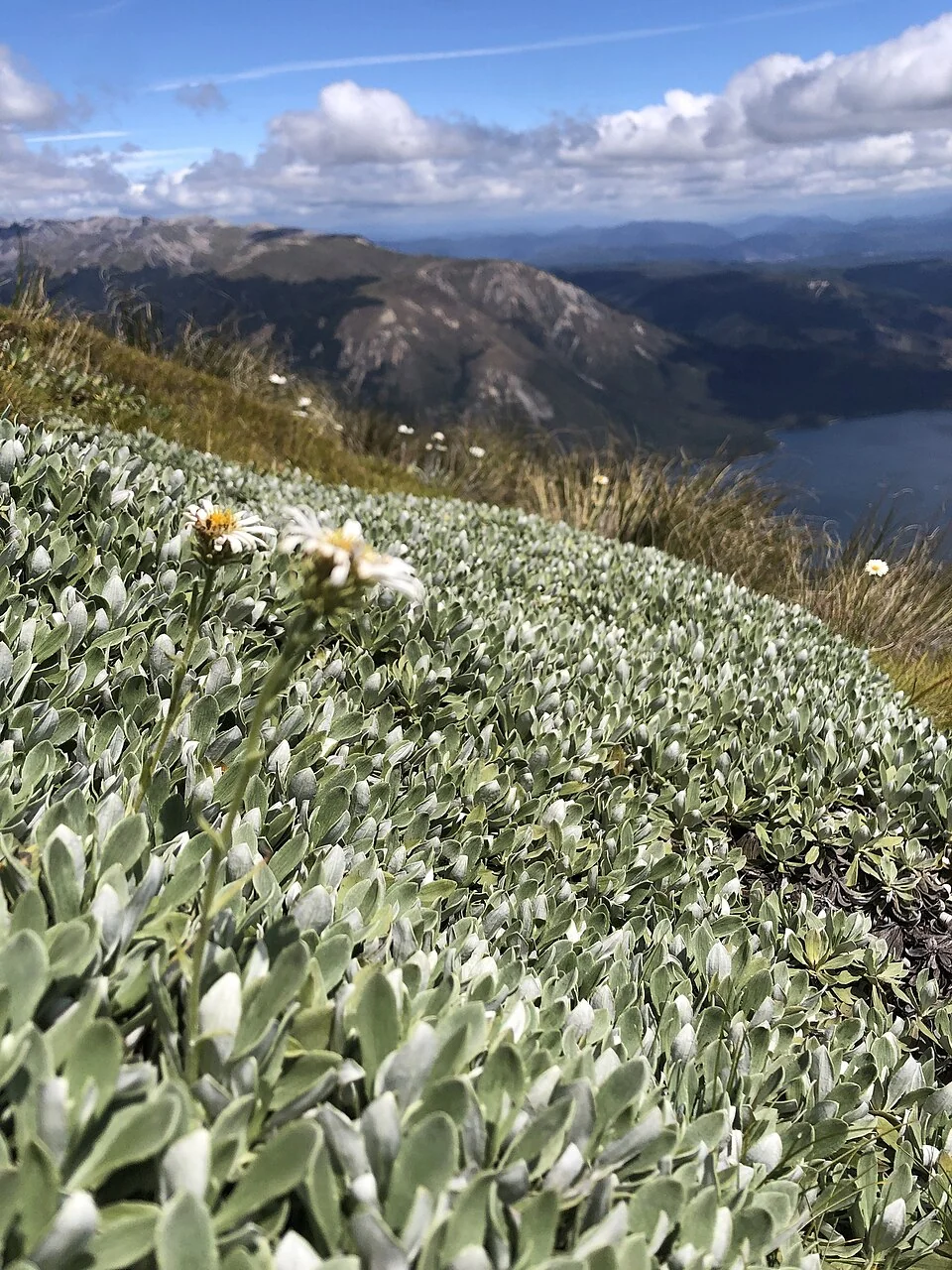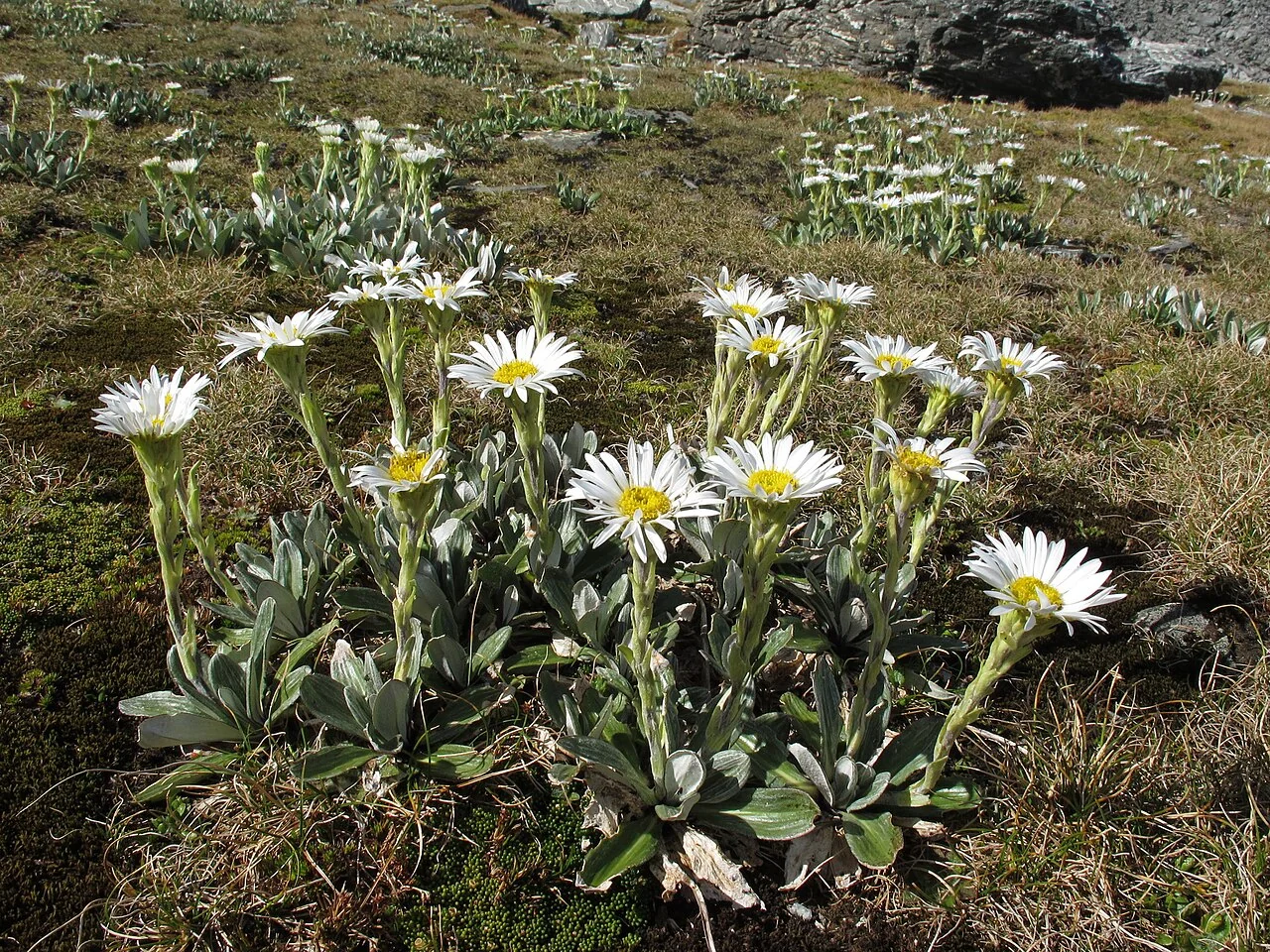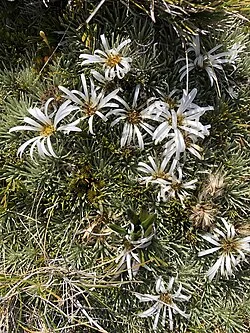
Cotton Daisy
Celmisia sessiliflora
Explore more NZ native plant guides in our index .
Introduction
Essential Information
Celmisia sessiliflora , commonly known as Cotton Daisy, is a charming cushion-forming perennial herb endemic to the alpine regions of the South Island of New Zealand. It forms dense, silvery-grey cushions of small, tightly packed leaves, giving it a distinctive woolly appearance. In summer, it produces small, sessile (stemless) white daisy-like flowers that nestle amongst the foliage. This hardy plant is well-adapted to harsh alpine environments, making it a unique and attractive addition to rock gardens and alpine troughs.

Plant Description
Celmisia sessiliflora , commonly known as Cotton Daisy or White Cushion Mountain Daisy, is a charming cushion-forming perennial herb endemic to the alpine regions of New Zealand's South Island. It forms dense, silvery-grey cushions of small, tightly packed, linear leaves, typically 1.5 cm long. These leaves are covered in short, appressed white matted hairs, giving the plant a distinctive woolly appearance. In summer, it produces small, sessile (stemless) white daisy-like flowers that nestle directly on the rosettes. This hardy plant is well-adapted to harsh alpine environments, thriving in exposed, rocky areas with excellent drainage and high tolerance to extreme cold, strong winds, and high UV radiation.
Quick Facts
Plant Specifications
| Scientific Name | Celmisia Sessiliflora |
|---|---|
| Height | 5-10 cm |
| Spread | 10-30 cm |
| Water Needs | Low; requires excellent drainage |
| Light | Full sun |
| Frost Tolerance | Very high |
| Salt Tolerance | Low |
| Growth Rate | Slow |
| Lifespan | Perennial |
Climate Best Suited to
Celmisia sessiliflora is endemic to the alpine and subalpine zones of the South Island of New Zealand. It thrives in very exposed, rocky environments with excellent drainage and is highly tolerant of extreme cold, strong winds, and high UV radiation.
Regional Suitability
| Whangārei | Ideal |
| Auckland | Ideal |
| Hamilton | Suitable |
| Rotorua | Suitable |
| Tauranga | Ideal |
| Gisborne | Ideal |
| New Plymouth | Ideal |
| Whanganui | Ideal |
| Palmerston North | Suitable |
| Napier | Ideal |
| Wellington | Ideal |
| Nelson | Ideal |
| Christchurch | Suitable |
| Dunedin | Suitable |
| Invercargill | Suitable |
| City | Climate Suitability |
|---|
Habitat
Natural Distribution
Celmisia sessiliflora , commonly known as Cotton Daisy or White Cushion Mountain Daisy, is endemic to the South Island of New Zealand, where it is found in alpine and subalpine environments. It is widespread across the South Island, from Nelson down to Southland.
This species typically grows in grasslands, herb-fields, fell-fields, and occasionally on rock outcrops. It forms dense, silvery-grey cushions of small, tightly packed leaves, well-adapted to harsh alpine environments. It thrives in exposed, rocky areas with excellent drainage and high tolerance to extreme cold, strong winds, and high UV radiation, making it a resilient component of New Zealand's high-country flora.
Plant Conservation
Celmisia sessiliflora is classified as "Not Threatened" under the New Zealand Threat Classification System. This indicates a stable population within its natural alpine distribution range. However, as a specialist alpine species, it faces ongoing conservation challenges from climate change, habitat modification, and recreational pressure in high-country areas.
This endemic South Island species is restricted to mountainous regions above 900 meters elevation, primarily in Canterbury, Otago, and Westland. Its specialized habitat requirements for cool, moist conditions and well-drained alpine soils make it vulnerable to warming temperatures and changing precipitation patterns associated with climate change. Populations may face upward migration pressure as suitable habitat shifts to higher elevations.
Conservation efforts focus on protecting alpine habitat integrity and monitoring population responses to environmental changes. The species benefits from protection within national parks and conservation areas, though recreational activities like tramping and skiing can create localized disturbance. Ex-situ cultivation in specialized alpine gardens helps preserve genetic diversity and provides insurance populations for this alpine specialist.
Climate change adaptation strategies include monitoring population trends, protecting habitat corridors that allow for altitudinal migration, and maintaining cultivation expertise for potential future conservation interventions. The species' striking appearance and conservation value make it an important flagship species for alpine ecosystem conservation in New Zealand.
Growing Requirements
Soil Requirements
Requires extremely well-drained, gritty, and very low-fertility soil. It is highly susceptible to root rot in wet or humid conditions.
Light Requirements
Thrives in full sun and exposed conditions, mimicking its natural alpine habitat.
Water Requirements
Extremely drought-tolerant once established. Water very sparingly, only during prolonged dry spells, and ensure excellent drainage.
Planting Guide
-
When to Plant
Plant in autumn or spring, ensuring the plant is well-established before extreme weather.
-
Site Preparation
Choose a very sunny, exposed site with exceptionally well-drained, gritty soil. Consider raised beds or rock crevices for optimal drainage.
-
Planting and Aftercare
Dig a shallow hole, ensuring the plant's crown is at or slightly above soil level. Backfill with a gritty, free-draining mix. Water once after planting, then allow the soil to dry out between waterings. Avoid overhead watering to prevent rot.
Ecological Significance
Celmisia sessiliflora , commonly known as the White Cushion Mountain Daisy, holds ecological significance primarily through its role as a prominent and endemic component of specific montane and alpine ecosystems in New Zealand's South Island.
- Habitat Contribution: As a mat-forming species, Celmisia sessiliflora contributes to the unique biodiversity of alpine and subalpine grasslands, herbfields, and fellfields. It is an important component of these high-altitude plant communities, providing ground cover and contributing to the overall structure of the ecosystem.
- Pollinator Support: Like other Celmisia species, its white flowers provide a food source for native pollinating insects, including flies, moths, and short-tongued bees, which are crucial for the reproduction of many alpine plants.
- Soil Stabilization: Its mat-forming growth habit likely contributes to soil stabilization in the often-eroded alpine landscapes, helping to prevent soil loss and support other plant life.
- Resilience in Degraded Grasslands: Some Celmisia species have shown resilience to disturbances like burning and stock grazing, and can become a major component of degraded grasslands, indicating a role in ecological recovery or persistence in altered landscapes.
Overall, Celmisia sessiliflora plays a role in maintaining the structure and function of New Zealand's alpine ecosystems by providing habitat, supporting pollinators, and potentially contributing to soil stability.
Uses and Significance
Garden Uses
- An excellent plant for rock gardens, alpine troughs, and crevice gardens.
- Its unique cushion habit and silvery foliage provide year-round interest.
Cultural Significance
Traditional Uses and Values
Cotton Daisy ( Celmisia sessiliflora ) holds cultural significance as a symbol of New Zealand's unique alpine flora and its resilience in harsh environments. While specific traditional Māori uses are not widely documented, the plant's distinctive cushion-forming habit and woolly leaves represent the specialized adaptations of native plants to the extreme conditions of the high country, inspiring appreciation for New Zealand's natural heritage.
Landscaping Uses
Garden Design Applications
Celmisia sessiliflora , commonly known as Cotton Daisy or White Cushion Mountain Daisy, is a unique and attractive perennial herb with several specialized landscaping applications, particularly in alpine and rock garden settings.
- Rock Gardens and Scree Beds: Its mat-forming habit and preference for alpine conditions make it an excellent choice for rock gardens, scree beds, and crevice gardens, where it can thrive in the well-drained, gritty soils it prefers.
- Alpine Houses: It thrives in alpine houses, particularly when grown in pots, where its specific environmental needs for cool temperatures and low humidity can be met.
- Container Displays: Due to its slow growth and compact size, it is suitable for container planting, making it an excellent feature for patios, balconies, or as part of a collection of alpine plants.
- Raised Beds and Troughs: Smaller Celmisia species, including C. sessiliflora , are well-suited for raised beds and troughs, where excellent drainage can be provided.
- Exhibition Plants: It can be cultivated as an exhibition plant in pots, showcasing its unique silvery-grey cushions and sessile flowers.
- Foliage Contrast: It can be utilized in general rock gardens to create striking foliage contrasts with other alpine plants, adding texture and visual interest.
For successful cultivation, Celmisia sessiliflora requires moist, well-drained soil and prefers a semi-shaded location, especially in warmer climates. It can tolerate frost, sun, shade, and wind, but it dislikes humidity and will not tolerate drying out. Due to its specialized requirements, it is considered difficult to grow and is not widely available commercially, making it a prized plant for dedicated alpine gardeners.
Seasonal Care Calendar
Spring
- Ensure good drainage as snow melts.
Summer
- Provide good air circulation; avoid overwatering.
Autumn
- No special care required.
Winter
- Protect from excessive winter wetness if grown in containers.
Pruning and Maintenance
Techniques and Timing
Celmisia sessiliflora generally requires minimal pruning. Focus on carefully removing any dead or discoloured foliage to maintain plant health and appearance, ensuring not to disturb its delicate cushion habit. This helps prevent fungal issues and promotes vigorous growth without stressing the plant.
How to Grow Cotton Daisy
From Seed
Celmisia seed is small and benefits from careful handling and alpine-like conditions. Collect seed as the heads ripen and dry; store cool and dry if not sowing immediately. For best results, give a brief cold period to break dormancy: mix seed with a little moist sand or vermiculite and cold-stratify around 4 °C for 4-6 weeks. Surface-sow onto a very free-draining, fine seed-raising mix and only dust with sand or vermiculite, as light helps germination. Maintain bright light, cool days and cool nights (roughly 10-16 °C), steady but sparing moisture, and excellent airflow to prevent damping-off. Germination can be slow and uneven, often taking 4-10+ weeks depending on freshness and temperature. Prick out tiny seedlings promptly into a gritty alpine mix (e.g., fine bark/grit/pumice) and grow them on in a sheltered position with bright light, cool temperatures, and careful watering. Harden off gradually and plant out into raised beds, rock gardens, or troughs with sharp drainage to emulate their natural alpine scree and herbfield habitats.
Division
Mature clumps can be carefully divided to maintain vigour and produce new plants. In early spring as growth resumes, lift the clump gently and tease apart sections so that each division carries healthy roots and a firm rosette. Trim away any dead or decaying material and replant divisions straight away into a very free-draining, gritty mix in pots or directly into raised rockery pockets. Water lightly to settle and keep just moist while roots re-establish; avoid waterlogging at all times. Provide full sun to high-light, cool conditions, shelter from hot, humid weather, and excellent drainage. Mulching with coarse grit around the crown helps keep foliage dry, reduces rot risk, and mimics natural alpine soils.
Pests and Diseases
Common Issues
Celmisia sessiliflora is generally pest and disease-free, especially when grown in its preferred well-drained, alpine conditions. The primary concern is root rot if conditions are too wet or humid.
Bonus Tip
Expert Growing Advice
For successful cultivation of Celmisia sessiliflora , a key tip is to provide a consistently moist, free-draining soil environment while simultaneously protecting it from high humidity and ensuring it never dries out. Watering from below in summer can help achieve this balance. This species is generally considered difficult to grow and thrives in alpine house pots or south-facing rockeries with full to partial sun, especially in semi-shaded locations in hotter climates.
